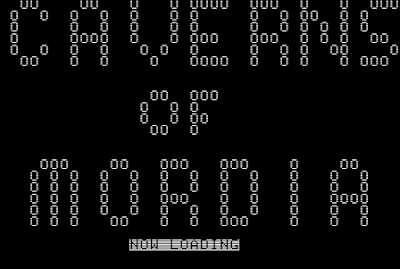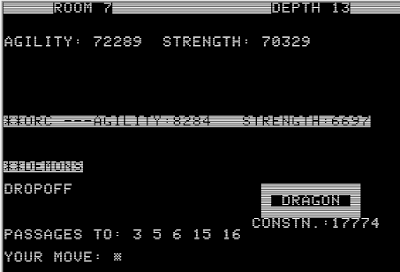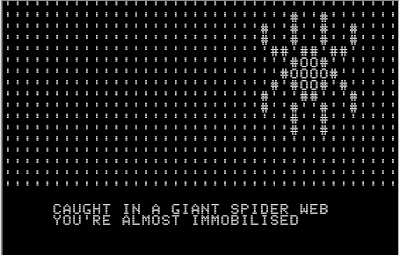From The CRPG Addict
Ranking at Time of Posting: (to come later)
In the case of Mordia, its unique contribution is to map every potential action that a player might take–subject, verb, and object–into a single numeric command. Where most games might offer a command for “attack” and then let you specify that you want to target the orc, Mordia puts that all together as command 22: Attack the Orcs. It’s almost like the game was developed by a police officer, used to describing every potential action or situation in a 10-code. Some of the many commands include:
- 30: Eat Lymphas [a type of bread]
- 33: Draw the double-handed sword
- 40: Use the net to trap dragons
- 50: Climb up one level
- 63: Remove the gas mask
- 66: Put on the gas mask
- 89: Open the chest
- 90: Attack the balrog
 |
| One of three pages of game commands. |
As I read and annotated the various commands, I couldn’t help but imagine all kinds of intriguing possibilities with this system. One problem is that all of the commands are manifestly useful in at least one room. It would have been fun if the author had sprinkled patently absurd commands throughout the list
- 32: Feed Lymphas to the orc
- 64: Put the gas mask on the dragon
I also imagined such a list extending to the complexity of a modern RPG:
- 10318: Stab the necromancer in the back, then run away and hide until he forgets about you, then enter sneak mode and stab him in the back again.
- 15906: Lead the deathclaw to the raider camp and watch the result from behind a nearby rock.
- 29055: Position the bodies of Ulfric Stormcloak and Galmar Stone-Fist in an obscene manner.
- 30117: Lasso and hog-tie the Skinner, heave him onto the back of your horse, ride 90 minutes to the swamps of Lemoyne, feed him to an alligator
Of course, such complexity is why the system was doomed to fail in the long run. You can’t have a unique command for drawing each weapon or attacking each monster unless you only have a few potential weapons and monsters. Still, it works for this game better than I thought it would when I first read the description.
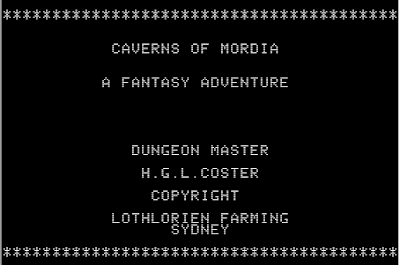 |
| The subtitle screen from the revised edition. |
The backstory has you play an agent of the wizard Pallandoin. Your mission is to deliver an Orb of Power to Lady Elleda of Locklorien, whose land is besieged by the forces of the evil spirit Sharnoscet. (In case it’s not obvious, almost all proper names in the game are slight alterations of characters and places in the Tolkienverse. “Sharnoscet” is an anagram for “Hans Coster.”) To get to Locklorien, you have decided to travel through the Caverns of Mordia, full of horrid creatures and encounters, because it is the route the enemy will least suspect.
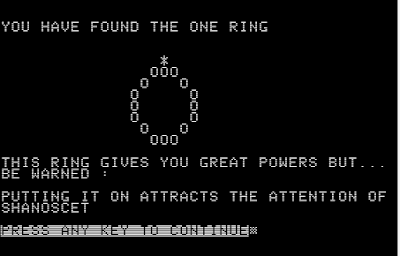 |
| The game suffers from a few originality issues. |
Character creation involves answering a few simple but unusual questions. After your name, you’re given the option to start at the surface with a basic kit or jump right into a lower level of the dungeon with a full set of equipment–in effect a shortcut for players who have already been through the opening a bunch of times. The normal exit to the game is on Level 25, but at the outset you can also specify that you’d like a second exit on Level 35, in case you fall down a pit or just want to amass a higher score before winning. I’m not sure that there are any drawbacks to saying “yes” to that question.
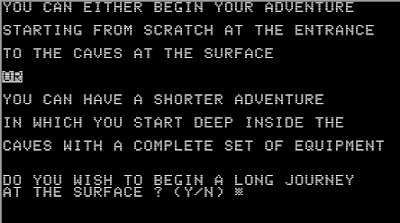 |
| A few questions during character creation. |
You begin at a dwarven market, where you don’t have enough gold to buy anything, but can later return. Your opening resources are a dagger, a dragon net, a magic staff, a wand, a lamp, the Orb of Power, 400 agility, and 400 strength. Strength serves as both literal strength and a health reserve.
 |
| The game begins in an empty room. |
Upon entering the caves, gameplay proceeds something like a roguelike with a concept map instead of an actual map. The dungeon consists of at least 35 levels. The manual is unclear, but it’s possible that levels are generated indefinitely (I made it to Level 44 before I died). Each level can consist of up to 16 rooms, with the contents of the room and the connections between them randomly established every time you change levels. They can even be reconfigured while you’re still on a level if you encounter “tremors.”
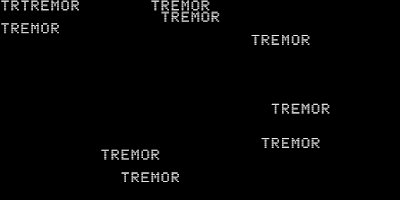 |
| A text simulation of an earthquake. |
Room 1 on each level is a special room in which you can do a couple of useful things. First, you can (Command 0) use the Orb of Power to return to the dwarven market and buy a gas mask (500 gold), a magic two-handed sword (3000 gold) or extra Lymphas Bread. Second, you can (Command 27) exchange your accumulated experience for extra agility or strength. You don’t always want to exchange all of it, however, because your unspent experience is used in some of the formulas for hitting and damaging monsters.
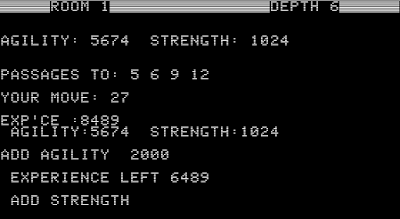 |
| Spending some of my hard-won experience. |
Other rooms can contain all kinds of perils depending on the dungeon level, including:
- Poisonous gas, which depletes your two characteristics unless you quickly put on a gas mask, and then the gas mask itself causes a 5% attribute loss per turn.
 |
| The game warns you about poisonous gas at the beginning, but you won’t be able to afford that gas mask for a while. |
- Drop-offs, including ones that you can see and hidden ones that dump you unceremoniously to the next level.
- Gusts of wind that blow out the lamp and make it impossible to see what’s in the room until you make a movement for a turn and the lamp re-ignites.
- Webs spun by the giant spider Araneida, which immobilize you for one or more turns.
- Orcs. You can kill them in regular combat.
- Dragons. You can also kill them in regular combat or try to trap them with a net first.
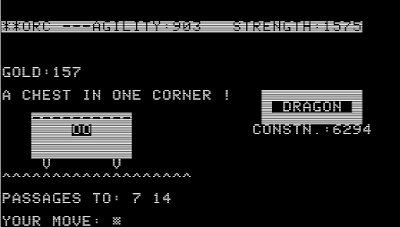 |
| A dragon and an orc guard this room with a chest. Because I have a Dragon Occular, I can see the dragon’s health. |
- Trolls. They always appear to guard the Mithril Armor. I believe they’re new to the second edition.
- Balrogs.
- Giant vampire bats.
- Demons, which can’t be killed through normal combat, only charmed.
- Araneida, the giant spider.
- Goblins, who can’t be attacked and simply steal one of your potential inventory items (the Dragon Occular) and flee.
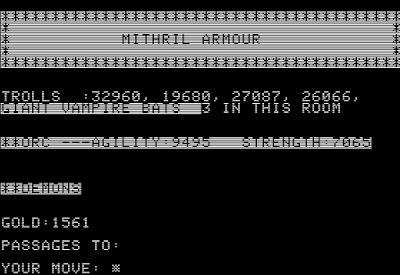 |
| Mithril armor is guarded by orcs, demons, vampire bats, and trolls. |
The same rooms can also contain useful equipment and assets, including:
- Gold. You can’t directly pick it up. Instead, every time you make a move, there’s a chance of grabbing a certain percentage of it.
- Chests with gold, elven flares, or Lymphas Bread. Chests can be trapped with serpents that bite you.
- The Charm Ring, which stuns demons.
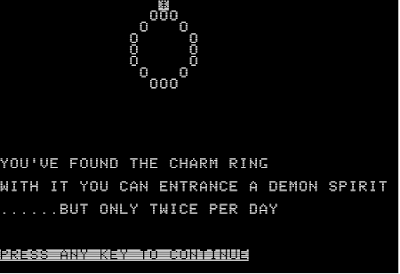 |
| Finding the Charm Ring is a key moment in early gameplay. |
- The Dragon Occular, which lets you see the relative strength of dragons
- Mithril Armor. I believe it is new to the second edition.
- The One Ring, which works pretty much as in the book. It renders you invisible while you wear it, but the “evil one” can sense its presence, and every turn you wear it carries an increasing chance of a debilitating spell. I also think this is new to the second edition.
Rooms with various assets and dangers are a staple of games in The Wizard’s Castle variety, but what keeps Caverns of Mordia unique is that any combination of these things can exist together in the same room. You might wander into a room with poison gas, an orc, 500 gold pieces, and 6 vampire bats, and then immediately have your torch blown out. You might descend into a room with an orc, and a dragon, have your Dragon Occular stolen by goblins, and then immediately fall through a hidden hole in the floor. You might be in the middle of a battle against four trolls for some Mithril Armor only to have a tremor reconfigure the dungeon level before you can defeat them.
 |
| A fairly simple room with demons, a few room connections, and a way up. |
You have a surprising number of options for dealing with these threats, all with potential risks. You can run away to another room, or climb up or down if those passages are open, but running carries a risk of getting swatted by enemies as you leave. You can simply attack with your dagger, or spend an extra round pulling out your two-handed sword (after you’ve bought it), but the sword sucks your strength every turn and only improves your chances against some monsters. You can light an elven flare to blind monsters and improve your chances of hitting them. You can use the staff, which will obliterate orcs, demons, bats, and poison gas and create a tunnel down, but only if it doesn’t backfire and damage you instead. You can try to reach Room 1 in a hurry by taking one of Araneida’s tunnels, but it carries a risk that she’ll bite you on the way. You can point a wand at the ceiling and try to create an escape hole upward.
 |
| A more deadly room on Level 6 has an orc, a dragon, and demons. |
In short, every room has a lot of tactical possibilities depending on who and what you find there, your current attributes, and what equipment you carry. Upon arrival in a room, you have to decide what takes priority, and whether it makes most sense to fight or flee. You get experience for every successful action, and it adds up fast. Your fortunes wax and wane with astounding swiftness. At times, I’d be down to a few thousand strength, reach Room 1 exhausted, and then find I had 600,000 accumulated experience points to pump into the attribute. Other times, I’d be wandering around confidently with over 100,000 in each attribute, fall through a few holes, meet a balrog, and get the “game over” screen.
Every nine moves, the game has you camp for the night–sometimes, this happens right in the middle of combat. (The manual hand-waves this by saying that you’re magically transported to a pocket dimension for the duration of your rest.) The sleep has a chance of adding 20% to each attribute, and it shows you a currently inventory and mission log when you awaken. You can call this report at any time with a numeric command.
 |
| The “cave report” is a simultaneous inventory screen, status report, and rest break. |
Overall, the strategy is to build agility and strength slowly on lower levels by killing orcs and charming demons. Rooms get more complex and events more chaotic the further you descend. Once you start killing dragons, and particularly once you start killing balrogs, your experience can increase by hundreds of thousands per level, but your strength and agility can also decrease with equal rapidity, and after Level 15, I was constantly searching for Room 1, often risking Araneida’s tunnel to get there. Such gameplay provided an exciting, nerve-racking experience, mitigated only by the fact that you can save every time you find Room 1 and teleport back to the dwarven market.
Although mostly text-based (and without any sound at all), the game occasionally offers some ASCII animation of your character fleeing battles or descending dungeons.
 |
| Running from monsters sends a little ASCII guy scurrying across the screen. |
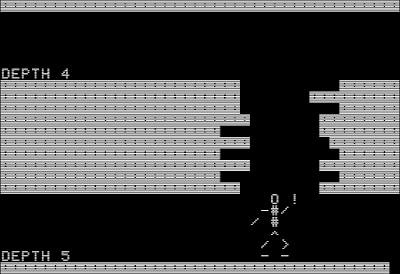 |
| The same guy transitions between levels. |
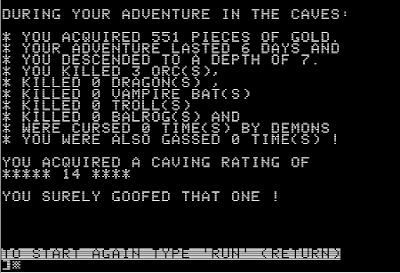 |
| This guy didn’t do so well. |
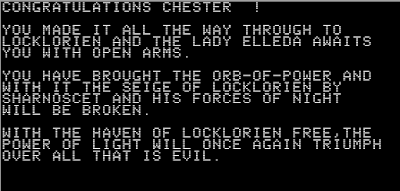 |
| The final text wraps things up nicely. |
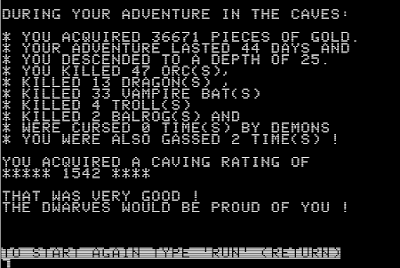 |
| My final stats for my winning character. |
Original URL: http://crpgaddict.blogspot.com/2019/01/game-316-caverns-of-mordia-1980.html

